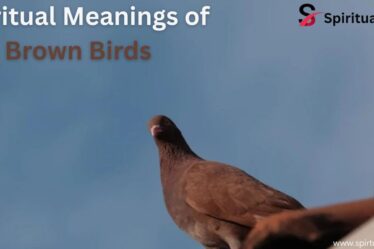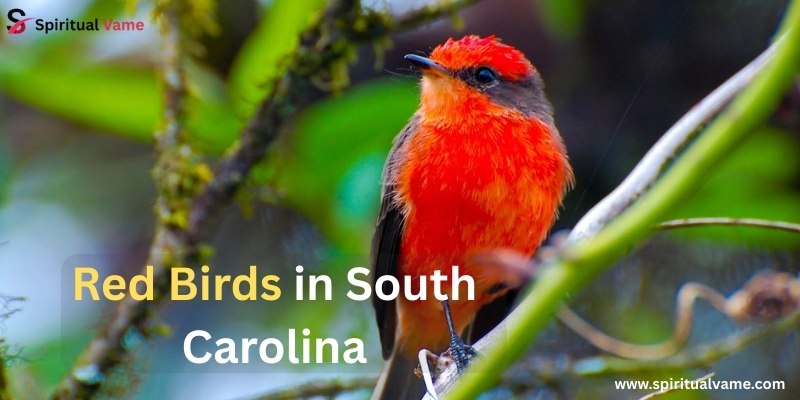
Red birds in South Carolina are some of the most beautiful and colorful birds you can see. These birds add bright reds and warm colors to the forests, backyards, and parks all over the state. Whether you are in the city or the countryside, you can spot many types of red birds in South Carolina throughout the year. From the famous Northern Cardinal to the bright Summer Tanager, these birds catch the eye with their vivid plumage and cheerful songs. Learning about red birds in South Carolina helps you enjoy nature more and makes birdwatching a fun hobby for all ages.
1. Summer Tanager (Piranga rubra)
The Summer Tanager (Piranga rubra) is a stunning migratory red bird found in South Carolina during the warmer months. This bird is known for its uniform bright red coloration and smooth plumage. It prefers to live in deciduous woodlands and forests where it spends much of its time in the canopy searching for insects, especially bees and wasps, which make up a big part of its insectivorous diet. The Summer Tanager migrates from Central America and South America, returning to breed in the United States each year. It is a medium-sized bird with a strong, straight bill designed for catching flying insects.
Unlike the Northern Cardinal, the Summer Tanager is more often found high in the treetops, making it a bit harder to spot. However, its bright red color can sometimes be seen contrasting against the green leaves. The bird’s cheerful warble and quiet calls are part of the summer forest soundscape. This species was first described by early naturalists such as Mark Catesby and later classified by Linnaeus, placing it within the genus Piranga.
2. Northern Cardinal (Cardinalis cardinalis)
The Northern Cardinal (Cardinalis cardinalis) is arguably the most famous red bird in South Carolina and the Eastern United States. It is a symbol of beauty and resilience in North America and is often one of the first birds beginners learn to identify. The male is bright red with a black face mask, while the female has a warm brownish body with touches of red on the wings and tail. Cardinals are known for their loud, clear songs, which males sing to defend their territory and attract mates during the breeding season.
This bird is a year-round resident of South Carolina, thriving in woodlands, gardens, and backyards. The Northern Cardinal’s diet is frugivorous and insectivorous, feeding on seeds, fruits, and insects. Its strong beak is perfectly adapted to cracking sunflower seeds, a favorite at feeders. Naturalists such as Louis Pierre Vieillot have studied this bird extensively, highlighting its important role in the local ecosystem. The Northern Cardinal is a great example of how a species can adapt well to human-altered landscapes, making it common in urban and suburban areas.
3. Pine Grosbeak (Pinicola enucleator)
The Pine Grosbeak (Pinicola enucleator) is a large, heavy-bodied finch that rarely visits South Carolina but is worth mentioning for its striking red plumage and unusual range. It usually lives in coniferous forests farther north but occasionally wanders south during the winter in search of food. When these birds appear in South Carolina, birdwatchers consider it a special treat. Males have a rosy red head and chest with gray wings, while females are mostly gray with some yellowish tones.
The Pine Grosbeak’s diet consists mainly of seeds and berries, and its large, powerful bill helps it crack open tough conifer cones. These birds are social, often found in small flocks during winter months. Their presence in South Carolina depends heavily on the availability of food sources in their usual northern habitats, which may cause irregular migration patterns known as irruptions.
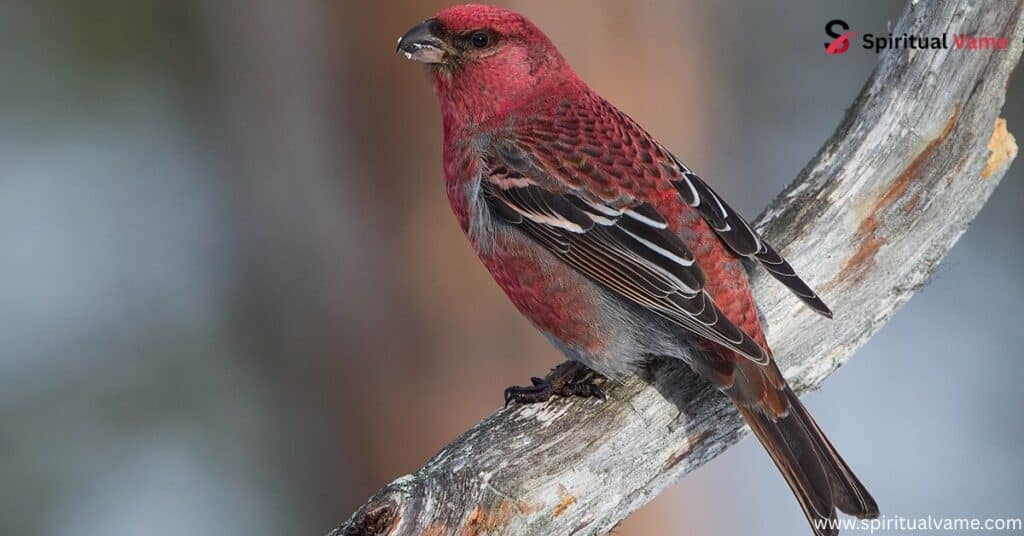
4. Purple Finch (Haemorhous purpureus)
The Purple Finch (Haemorhous purpureus) is another beautiful red bird that visits South Carolina mostly during migration and winter. It has a raspberry-red head, chest, and back with white underparts, making it distinct from the House Finch, which is more common in urban areas. The Purple Finch breeds farther north and prefers coniferous and mixed forests. It feeds on seeds, berries, and insects, using its short, strong beak to break open seeds.
Though less common than the House Finch in South Carolina, the Purple Finch adds vibrant color to birdwatching trips during the colder months. It has a sweet, musical song that is softer than the cardinal’s but still pleasant to hear. This species plays an important role in the ecology of North American forests, especially by helping to disperse seeds.
5. Painted Bunting (Passerina ciris)
The Painted Bunting (Passerina ciris) is one of the most colorful and unfamiliar red birds you might see in South Carolina. Males boast a brilliant mix of red, blue, and green feathers that make them stand out even among other songbirds. The red on the male’s breast and face is particularly eye-catching. These birds prefer shrubby areas and woodland edges, where they forage for seeds and insects. Painted Buntings breed in the southeastern U.S., including parts of South Carolina, and winter further south in Central America.
The species is known for its shy and secretive behavior, often hiding deep in dense foliage. Birdwatchers are thrilled to spot one, as they are not as common as Northern Cardinals or House Finches. Conservation efforts focus on protecting their breeding habitats and reducing threats from habitat loss and trapping for the pet trade.
6. Red Crossbill (Loxia curvirostra)
The Red Crossbill (Loxia curvirostra) is a fascinating red bird known for its unique crossed bill that helps it extract seeds from conifer cones. This adaptation is rare among birds and is an excellent example of evolutionary specialization. These birds live mainly in coniferous forests but occasionally wander to South Carolina during irruptive movements when cone crops fail farther north.
Red Crossbills are often seen feeding in flocks and have a varied vocalization that helps keep the group together in dense forests. Their diet consists mainly of pine and spruce seeds, which they skillfully pry out using their distinctive bill. These birds are important in maintaining the health of conifer forests by helping control seed populations.
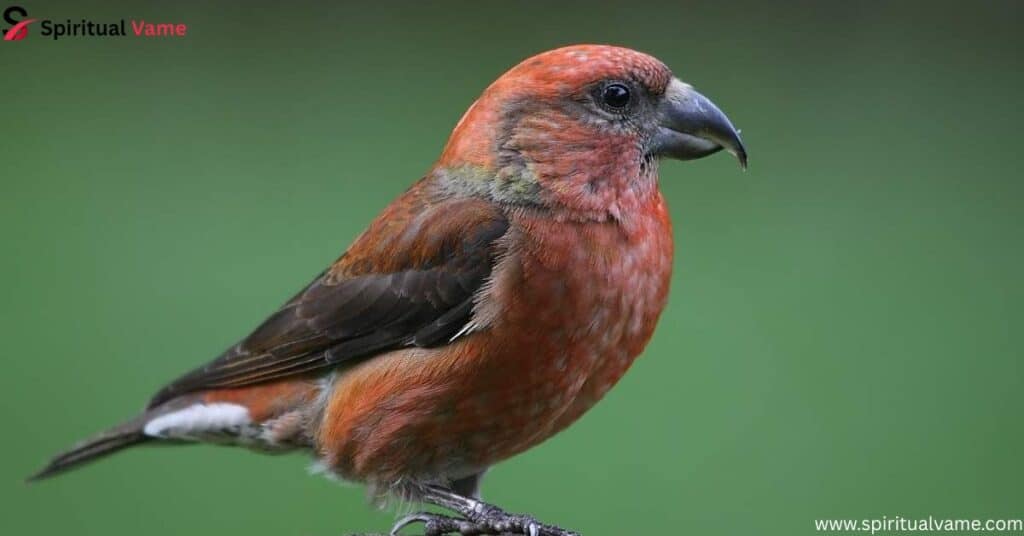
7. Scarlet Tanager (Piranga olivacea)
The Scarlet Tanager (Piranga olivacea) is a striking red bird with black wings and tail, found in South Carolina during the breeding season. It spends most of its time high in the forest canopy, where it hunts insects and fruit. This bird migrates to South America for the winter, showing a long and challenging migratory journey. The bright red and black coloration is a great example of sexual dimorphism, where males and females look very different.
The Scarlet Tanager’s song is a series of robin-like phrases and harsh calls, often heard in deep woods. It prefers large, mature forests with dense tree cover for nesting. Because of habitat loss, this species is of conservation concern, and birdwatchers treasure the chance to observe it during the summer months.
8. Common Redpoll (Acanthis flammea)
The Common Redpoll (Acanthis flammea) is a small finch with a bright red forehead patch and streaked brown body. It is a rare winter visitor in South Carolina, usually coming from the Arctic regions to escape harsher conditions. These birds feed on seeds from birch and alder trees and have the remarkable ability to survive in extremely cold climates.
Redpolls travel in large flocks and are known for their cheerful chirps and active behavior. Spotting one in South Carolina is exciting for birdwatchers, as they only show up irregularly depending on food availability in northern breeding areas.
9. White-winged Crossbill (Loxia leucoptera)
The White-winged Crossbill (Loxia leucoptera) is closely related to the Red Crossbill but has striking white wing bars and a similarly crossed bill. This bird also relies on conifer seeds and lives mostly in northern forests. Occasionally, it irrupts southward into South Carolina, offering a rare sighting for enthusiasts. Their social flocks and unique bill adaptation make them stand out among other finches.
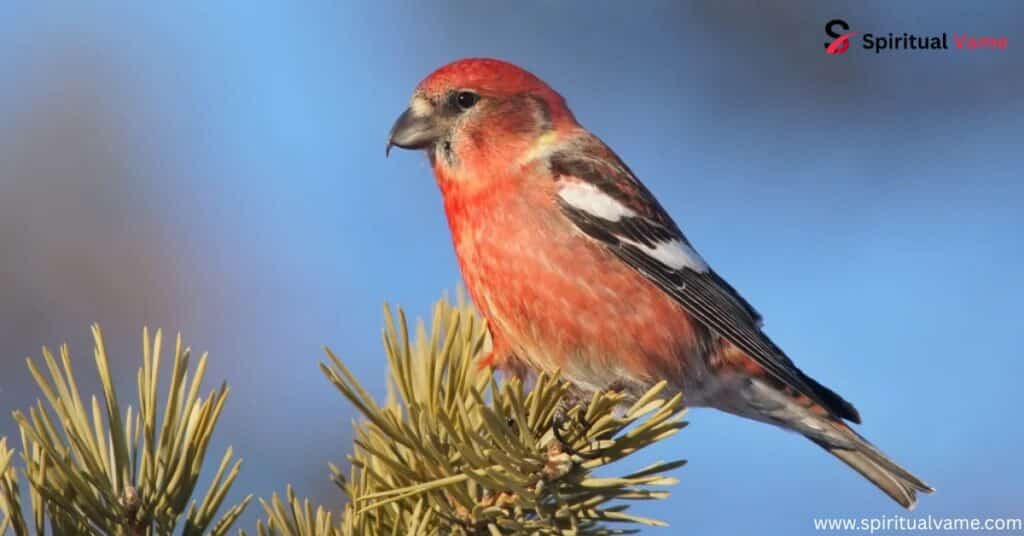
Attracting Red Birds to Your Yard
If you want to enjoy watching red birds in South Carolina right from your backyard, there are several things you can do. Using bird feeders stocked with sunflower seeds, safflower seeds, and nyjer will attract many species, including Northern Cardinals, House Finches, and Purple Finches. Planting native berry-producing shrubs and trees such as dogwood, holly, and serviceberry will provide natural food and shelter. Fresh water sources like birdbaths are essential, especially during dry seasons.
Avoid pesticides and herbicides to maintain a healthy insect population, which many red birds like the Summer Tanager rely on for food. Providing dense shrubs or brush piles will offer protection for nesting and roosting. Seasonal changes affect which species visit, so maintaining your feeders year-round is ideal to support both resident and migratory birds.
The Role of Red Birds in the Ecosystem
Red birds in South Carolina are not just beautiful; they play important roles in maintaining a healthy ecosystem. Many, such as the Summer Tanager and Scarlet Tanager, help control insect populations by feeding on bees, wasps, and caterpillars. Others like the Northern Cardinal and House Finch aid in seed dispersal by eating fruits and berries and spreading seeds through their droppings.
Their bright colors and songs also contribute to the biodiversity and soundscape of forests and woodlands, signaling a healthy environment. These birds are indicators of environmental change and habitat quality. Conserving their habitats supports broader ecological networks, benefiting many other species, including pollinators and mammals.
Types of Red Birds in South Carolina
South Carolina hosts many species of red birds, ranging from the very common to the rare. Besides the Northern Cardinal, you can find the Summer Tanager, Scarlet Tanager, and the House Finch, which often visits feeders in suburban areas. The striking Red-headed Woodpecker (Melanerpes erythrocephalus) is another colorful resident known for its bright red head and black and white body.
The Vermilion Flycatcher (Pyrocephalus rubinus), a rare visitor, adds fiery color with its vivid red body and distinctive flycatching behavior. The Pine Grosbeak and Red Crossbill are more northern species that occasionally visit South Carolina during winter irruptions. The Purple Finch and the elegant Rose-breasted Grosbeak (Pheucticus ludovicianus) also grace the region, especially during migration.
Each of these species plays a unique part in the birdwatching experience and ecosystem health, from the small and secretive to the bold and flashy.
Conservation and Bird Watching Tips
When observing red birds in South Carolina, it’s important to follow ethical birdwatching practices. Use binoculars to avoid disturbing nests or feeding birds. Keep a respectful distance, especially during the breeding season when birds are more sensitive to disturbances. Logging sightings with apps like eBird helps scientists track populations and migration patterns.
Protecting natural habitats is key to conserving these species. Support local conservation efforts and plant native trees and shrubs to provide food and shelter. Maintain clean feeders and water sources to prevent disease. The best times for spotting red birds are early mornings and late afternoons when these birds are most active in feeding and singing. By learning their songs and calls, such as the clear warble of the Northern Cardinal or the sharp chirp of the Summer Tanager, birdwatchers can better locate and identify them in their natural habitats.
Conclusion
The variety of red birds in South Carolina adds vibrant color and lively sounds to forests, woodlands, and backyards throughout the year. From the well-known Northern Cardinal (Cardinalis cardinalis) to the migratory Summer Tanager (Piranga rubra) and rare visitors like the Pine Grosbeak (Pinicola enucleator), these species enrich the biodiversity and ecological balance of the region. Understanding their behaviors, diet, and habitats allows us to appreciate their role in the ecosystem and encourages us to take part in their conservation.


